
If you’ve been reading this blog, you know that last week I returned from the 2023 Burning Man festival in northern Nevada. It was a terrific event, full of excitement and artistic energy – until it rained. Then it became a less than wonderful mud bog. We managed; we survived; we will return next year and try again.
My camp is called the Pinhole Project. Our artistic endeavor is to document the art installations at Burning Man using large pinhole cameras on photographic paper. For this we have 10 55-gallon Kraft paper barrels, each with metal plates glued inside, and each with a precision-cut pinhole aperture in a sheet of aluminum that is cemented into the side of the barrel. On top of each pinhole is a “shutter” made out of gaffer’s tape.
We insert a large sheet of photo paper into each barrel in our darkroom – built inside a 20-foot container cargo box – and hold that paper in position with magnets. We then put a steel lid on each barrel, making the entire thing light-tight. Once loaded with photo paper, the cameras are ready for the field.
Every morning we hold a public workshop in our gallery. Interested people show up, sometimes in surprising numbers. We explain how the cameras work, how we develop the photos, and how we re-photograph each finished photo for our digital archive. At the end of the workshop, we invite those present to join us on the Playa to make new photographic images. We have a big pick-up truck for transporting the cameras.
The photographic paper we use is made by Foma in the Czech Republic. It’s designed for use under an enlarger in a darkroom, so the ISO is not published. But we have a Weston Master V light meter and we have used it to estimate the paper’s ISO at about 0.3. This requires a long exposure in the bright sunlight of the Black Rock desert. Our typical exposure time is about 45 seconds.
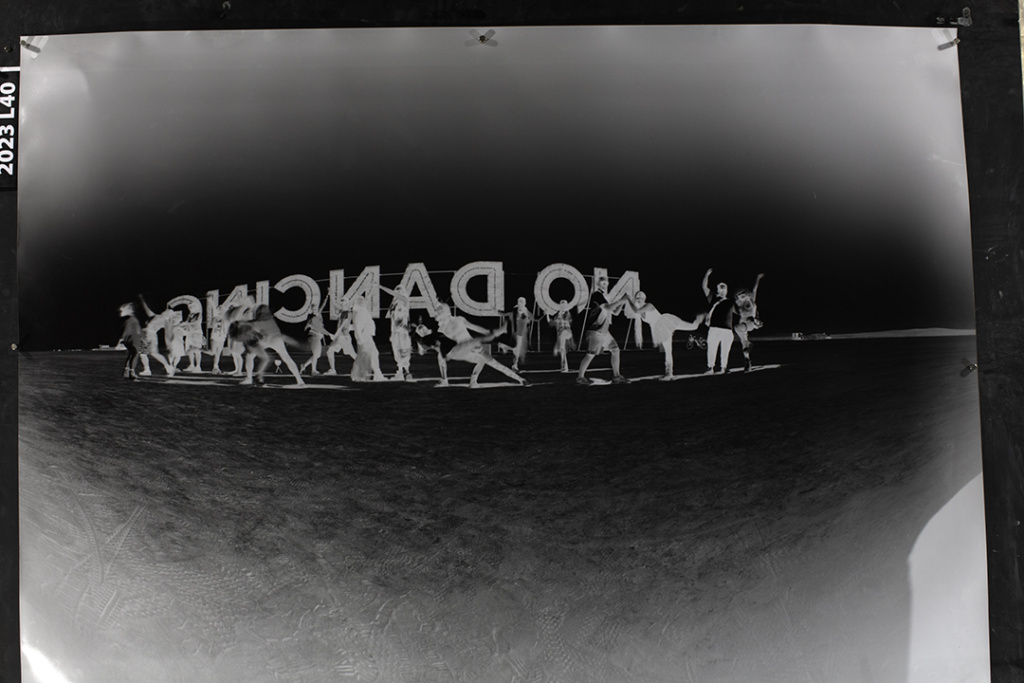
If people will be the subject of a pinhole photo, those people must stand still for 45 seconds –which is very difficult. We do our best, and the results are very impressive.
One day I took the group out onto the Playa to make photos. I had an idea I wanted to explore. There was a huge sign erected on the Playa saying “NO DANCING” – and I decided to take a large pinhole photo of a bunch of people dancing in front of that sign. It was a simple photo to organize, moving people into place, moving the camera to the right spot. We use wooden camera supports that look like medieval torture devices; each is a plywood piece with teeth on each side. There are two level edges for each tooth so that the large barrels can be placed in a number of positions on the support. We often add a bungee cord to stabilize the camera in wind.
The No Dancing photo turned out very nicely, and I am very proud of it.

A couple of days later I went back out on the Playa with a friend and we took three more large pinhole photos. Mine was a horizontal portrait of three inflated spheres of the Earth, the Moon and Mars that were on the edge of the Playa. These works were exceptional. They were printed on Mercator sections of fabric, then sewn into complete spheres. Illuminated at night, they were a spectacular sight.
I set up the camera and took a one-minute exposure –it was slightly overcast. Then we moved on to take a couple of other images.
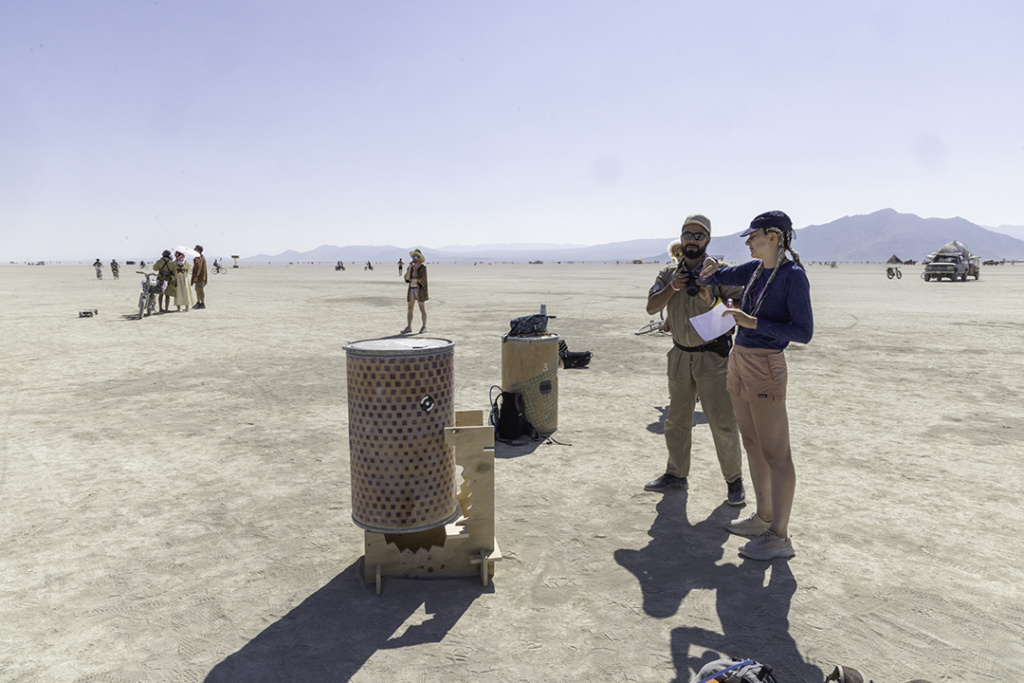
Back in the darkroom, we processed all that day’s images, and mine looked very nice. But Mars had an egg shape, a significant distortion of its otherwise spherical shape. I knew this had not been caused by wind, so I assumed it was a camera distortion. Occasionally we have a sheet of photo paper fall inside the barrel when a magnet isn’t placed correctly. This usually causes blockage of part of the image, but it doesn’t cause distortion.
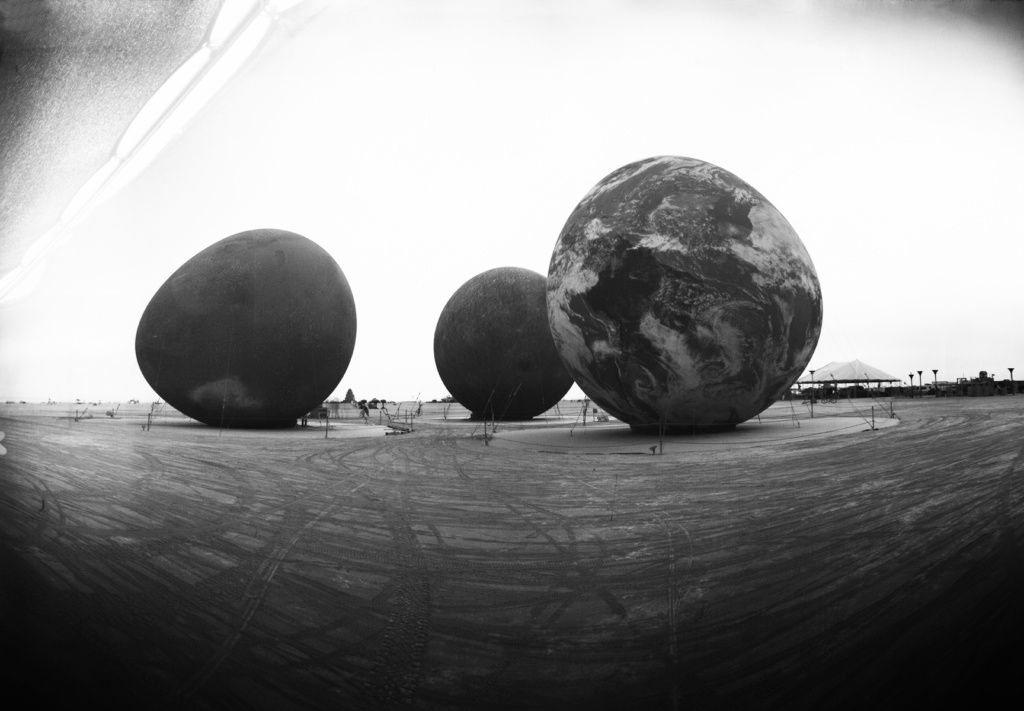
I needed to understand why this distortion was there.
I have drawn two pinhole cameras here: one is the camera we use at Burning Man. It’s a Kraft paper 55-gallon drum with its pinhole aperture on one wall of the camera. The other is an idealized pinhole camera that has its aperture at an optical center that is equidistant from all points of the photo material.
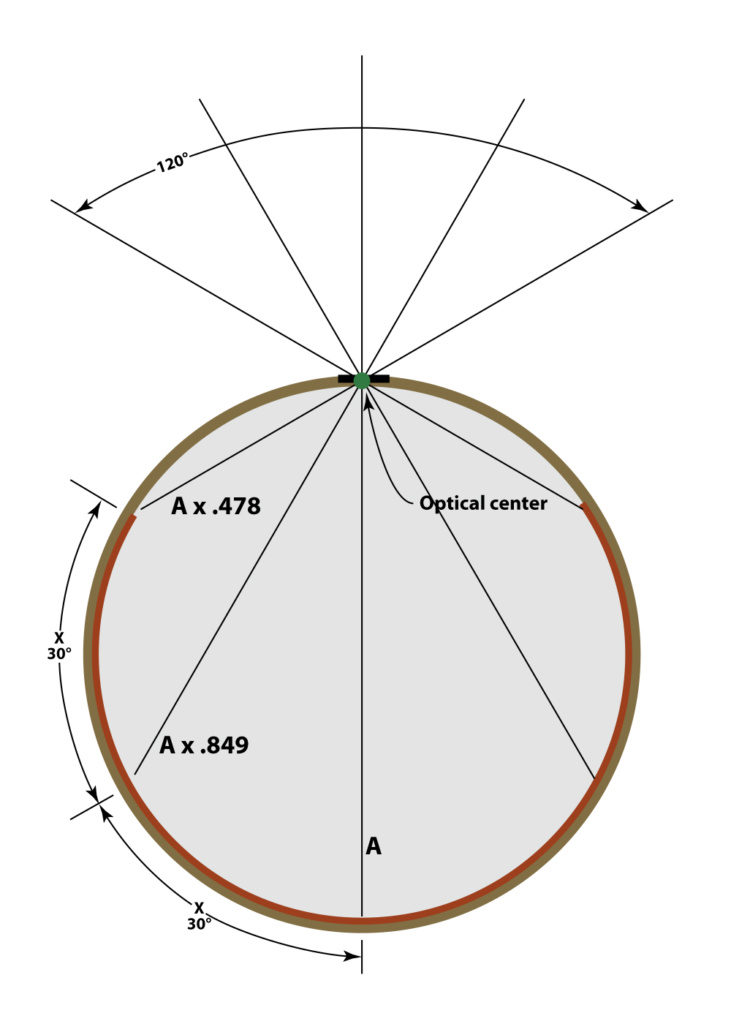
The current camera is far from ideal in terms of its optical path. Light coming in on the edges travels slightly less than half the distance that light travels in the center of the image. I am pretty sure this explains the distortion. The light along the outer edges of the image is traveling much less than the light in the center, and thus, it is being distorted along one axis. The other axis is affected similarly, but to a lesser degree because it’s a smaller difference between the center and the edges of the photo paper.
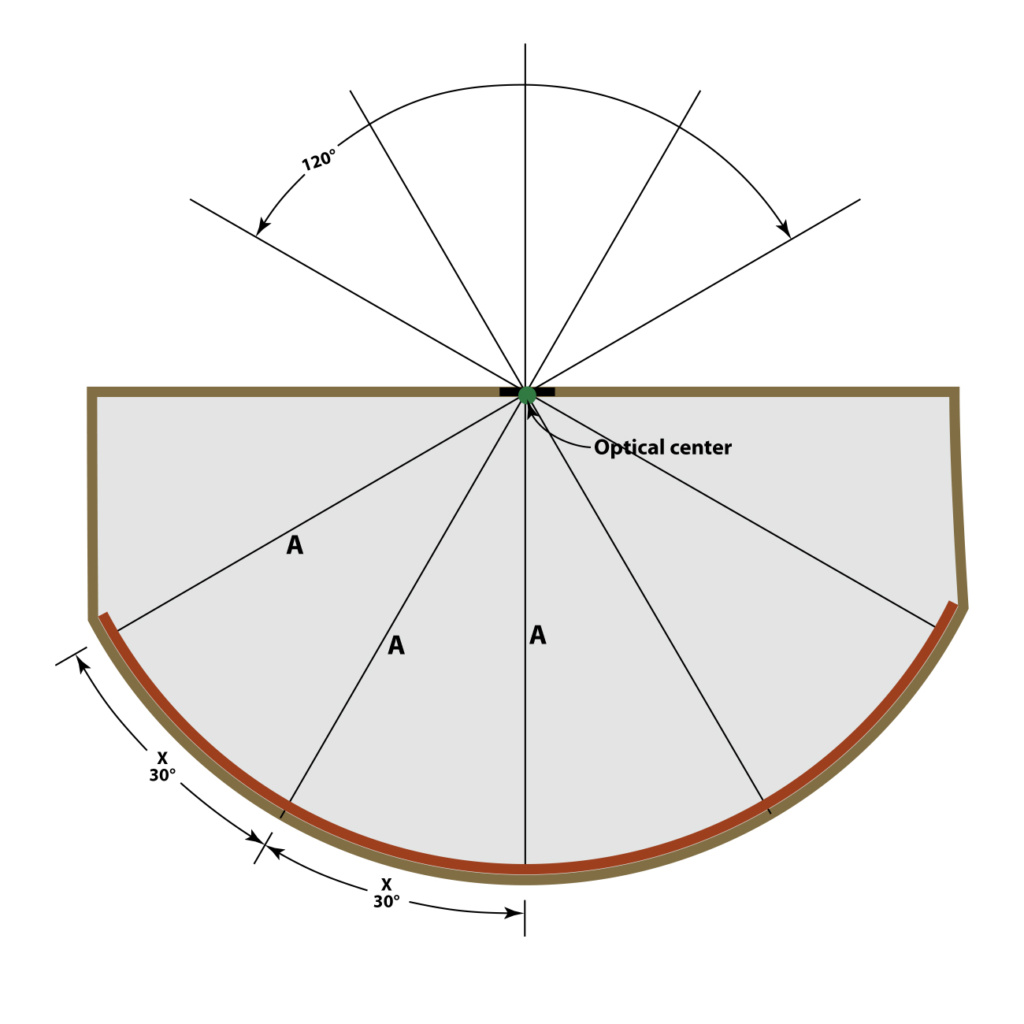
The idealized pinhole camera would be pretty easy to make and test. I might try it by inserting a modified film plane into a barrel to normalize the distance that the light travels after it enters the camera through the aperture. With that I am quite sure that optical distortion would be eliminated on the circumferential axis.
I’ll keep you posted!

It seems that there are distortions in multiple axes. Otherwise wouldn’t it be an oval?
Hi Bryn
I see those. I think they are caused by the paper not being perfectly flat against the back of the drum. We only pin the corners with magnets, and sometimes the sheets don’t fit perfectly. It could also be caused by the lens not being perfectly centered in the drum, or the paper not being centered inside. There are a small handful of possibilities. The vertical axis also suffers from differences in distance from the aperture to the paper. The drum is the 30.75 inch direction (short dimension). Therefore the distance from the pinhole to the edge is greater at the ends than the middle. The circumferential dimension is 42 inches, and that’s where we see the egg-shape in the left sphere. It’s also possible, though I didn’t see it, that the inflated spheres are not perfectly round.
Best wishes,
Brian
Yes vertical axis seems like it has significant deviation in light path length. Perhaps you could make a Mercator sections out of wood, with a vacuum table at the back to suck the film paper tight and that would make it easier to roll to its destination
Hi Bryn,
I agree. I think if I could master the 3D capabilities of our router I could do that! And, I am going further! I’m designing a small nuclear reactor for next year’s Burning Man. Where 5KW is adequate this year I am planning for 5MW next year!
Thank you for your comments,
Brian
Sorry for the typos on my phone. I gather you figured I meant Mercator sphere . Happy to assist if I can with that. You’re on your own for the reactor tho 🙂 have you seen the game factorio? It’s my favorite of all time. Like simcity but for factories where you start by smelting ore yourself and by building automation eventually get to build reactors and rockets and escape the planet. The unofficial motto of players is “the factory must grow” and it sounds like “the playa must grow”
Hi Brian,
The (small, neglected) physicist in my head thinks that it’s not about the distance the light travels, but the angle at which the light hits the paper (though perhaps that’s what you mean). As an example, think about a flat piece of paper on the floor and a flashlight with a lens that creates a nice circle of light when the flashlight is held directly above the paper. Consider what the circle of light would look like if the flashlight was pointed at the paper when held in your hand and standing 10 feet away from the side of the paper. It would produce an oval.
In your pinhole camera, the center of the camera would produce the expected round aspect ratio but the edges have such a low angle of incidence that the image would be quite stretched indeed (great diagram BTW). Perhaps your photo size is a bit too ambitious for the size of the barrel? Or maybe a Burning Man-sized barrel is in order…
I totally agree that the optimized design would fix the problem. You have all the light hitting the paper with the same angle of incidence.
Great work! I look forward to seeing more of it
Hi Steve,
I agree with the small, neglected physicist on this. It is absolutely related to the angle at which the light is striking the paper in the drum. On the edges it’s quite acute, while in the center it’s straight-on.
I might try to make the idealized version of the camera, but that depends on my commitment to fixing a problem that really isn’t a problem. These photos are works of art, and not intended to be accurate.
It’s always nice to hear from you.
Best wishes,
Brian
It’s funny, I have to stop myself… My tendency is to start thinking about solutions in the digital realm and how an image map could be constructed that used information from your diagram to correct for the distortion caused by the angle-of-incidence issue…
Then I have to remind myself that it is explicitly intended as an analogue art form and it stands very well on its own!